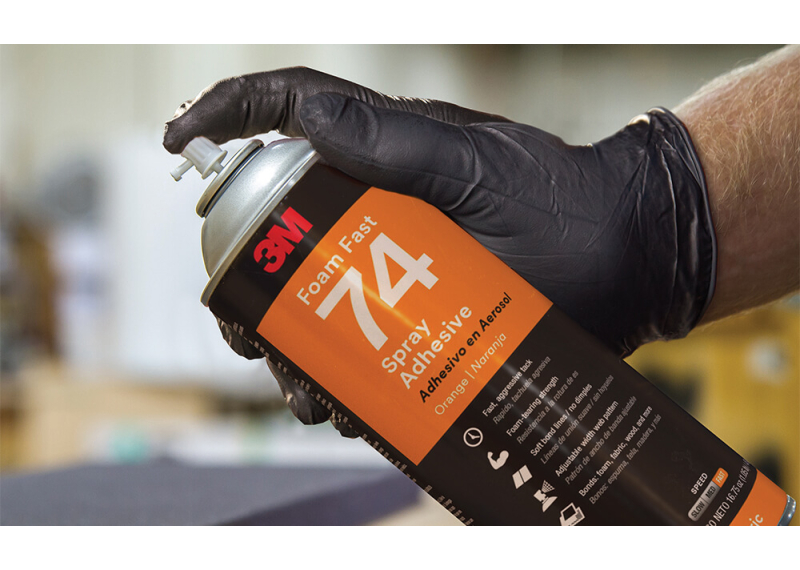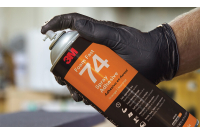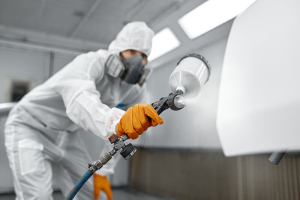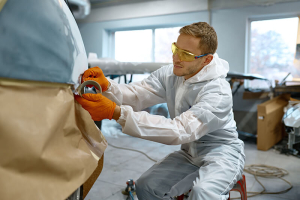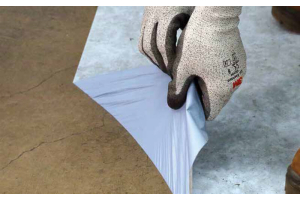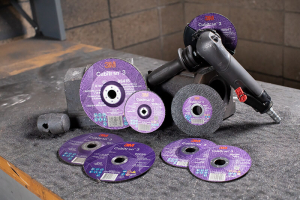Are You Ready To Upgrade Your Spray Adhesives?
Check Out These Three Top
Spray Adhesive Options
Why are you still using inconvenient old-fashioned bulk adhesives when you can switch to an aerosol adhesive? With these easy spray bottles, you don't have to mix anything because they're premixed and pre-pressurized. You can start using them immediately and clean-up is practically non-existent!
To give you some ideas about newer spray adhesives to consider, we're going to look at three products - the 3M Heavy Duty 20 Spray Adhesive, 3M Multi-Purpose 27 Spray Adhesive and 3M Foam & Fabric 24 Spray Adhesive.
They still have all the qualities of the 3M 77 and 3M 80 aerosols, just at a lower price point. To do this, they reformulated the product with less expensive materials and made smaller cans.
When you use it, you'll notice a little stronger smell due to the methyl acetate, which is used as the primary solvent. Make sure you protect yourself by using this adhesive in a spray booth or open area with adequate ventilation.
If you have to spray it in a confined area, make sure you're using fans to keep clean air flowing. There are flammable propellants in aerosol products generally, so please stay safe and ventilate!
Now let's take a closer look at each of the three spray adhesives:
3M Heavy Duty 20 Spray
Versatile and strong, the 3M Heavy Duty 20 Spray is an excellent contact adhesive made to bond high-pressure laminate (countertops), plastics, soft foams, fabrics, leather, metal or wood products.
Its three-step nozzle is designed to give you a controllable lace pattern for everything from a light to heavy application. The aerosol sprays a straight, even line so you can go right up to the edge without having to deal with overspray. The spray is translucent, so it never shows on exposed edges. As a contact adhesive, you have to make sure both materials are covered.
It dries in just one minute, but will need 30 minutes for the full bonding time. For best results, let both sides dry completely before bonding, so you don't trap solvent in the glue line. If you're working with porous substrates, you can speed it along a little bit.
To test it, tap your knuckle in the adhesive. If the adhesive transfers to your knuckle, wait a little longer and try again. You know it's ready when it's “grabby” and stays put.
And like all bonding processes, take the time to line everything up correctly or it will bond incorrectly. Then you're looking at a mess that will cost you valuable time to chip and tear it as you try to separate it.
If you're working with a particularly tough bond, you can spray a second coat in the opposite direction and let it dry a little longer.
3M Multi-Purpose 27 Spray Adhesive
The 3M Multi-Purpose 27 Spray Adhesive is very different from the 20 and is designed specifically for lightweight materials. This product is ideal for bonding paper, fabric, leather, foams and foils to themselves, as well as metal, plastic, glass or painted surfaces.
This is an especially good choice for crafters working with paper or cloth because it's able to make great bonds without leaving thick glue lines. It also won't soak through paper - it just lies on top without soaking through. It also dries quickly and doesn't damage the top side of your paper or cloth.
For manufacturers, the 3M Multi-purpose 27 Spray Adhesive is great when you need to bond shipping labels to products, hold fabrics together prior to stitching, permanently bond carpet as well as hundreds of other applications.
The nozzle is designed for precision spraying, and creates a fine mist in a flat spray pattern with very defined edges so you can always get clean lines on your products.
And when you're looking for a less expensive option to the 77 Spray, consider the Multi-Purpose 27 Spray Adhesive. It's a little smaller can with fewer solids but it's a good option for these products. And when using, make sure you have a good clean airflow to help keep the vapors under control.
3M Foam and Fabric 24 Spray Adhesive
For our last option, we're going to look at the 3M Foam and Fabric 24 Spray Adhesive. Unlike the other two, which are good general choices for your shop, this one is specifically designed for foam and fabric.
While a general spray adhesive is designed to wet out the surface, foam and fabric have different requirements. In this case, the adhesive needs to sit on top without soaking through the fabric or filling up the cavities in the foam.
Remember that foam is especially difficult to work with because the adhesive tends to “dive into” it. When this happens, the pressure applied to make the bond collapses the cell structure, making the foam thinner or leaving handprints.
When working with upholstery or pillows, spray adhesives present a bigger challenge. Often, the spray adhesives will create a stiffer spot that can be felt through the fabric. To combat this, the 24 Spray bonds very quickly and has a precise spray pattern and a soft glue line.
One caution - the adhesive is a little bit amber colored so it does show up when sprayed, so be careful with overspray. It is also a pressure sensitive adhesive that remains tacky for several hours.
I did a bonding test on three different foams, some fabric and a piece of polyester batten to see how this product worked in each use. I found that the Spray 24 grabbed within 30 seconds of spraying and held firmly. It was completely bonded in about 5 minutes and everything self-destructed when I tried to pull them apart.
Although the smell isn't too strong, remember that you need to use fans with all aerosols. Although none of the adhesives in this test are solvent free, there is some good news - methylene chloride, a known carcinogen,isn't used in the product any more.
Best Tips For Cleaning Your Spray Adhesives
To get the most use out of your spray aerosols, make sure you clean the nozzle thoroughly. To do this, find a trash can, invert the spray can into the container and spray for a couple of seconds until it is only spraying propellant.
This keeps the nozzle clean and ensures the valve in the top of the can will spray perfectly the next time you use it.
Before reaching for your typical bulk adhesives, give one of these aerosol adhesives a try the next time you need to bond materials. You may find that you like them better and they can save you some money, too!
Ready To Learn More?
Have more questions? Check out our spray adhesives page to learn more about how to use it in your manufacturing operations.
See Why We're The Top Supplier For Industrial, Marine and Safety
30-Second Summary:
- ✔ While bulk adhesives may be the norm, they can be time-consuming and costly to use.
- ✔ Pre-packaged aerosol adhesives offer a faster, easier and cheaper way to bond materials.
- ✔ We reviewed three 3M products to help you find a new product designed for your manufacturing needs.
- ✔ Versatile and strong, the 3M Heavy Duty 20 Spray is an excellent contact adhesive made to bond high-pressure laminate (countertops), plastics, soft foams, fabrics, leather, metal or wood products.
- ✔ The 3M Multi-Purpose 27 Spray Adhesive is designed specifically for lightweight materials.
- ✔ 3M Foam and Fabric 24 Spray Adhesive is specifically designed for foam and fabric.
- ✔ When using aerosols, make sure you're properly ventilating the area with a steady supply of clean air.
- ✔ Clean the nozzle thoroughly. To do this, find a trash can, invert the spray can into the container and spray for a couple of seconds until it is only spraying propellant.

